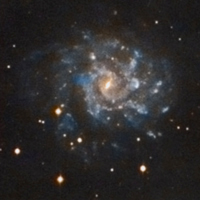This page is dedicated to Edward Fath and his
groundbreaking work that led to the true nature of Spiral Nebulae,
now known as spiral galaxies.
At the end of the 19th century astronomer
James E. Keeler began a series of nebular photographs at the Lick
Observatory. He found the nebulae had spiral structures, and
could not be within the Milky Way.
In 1908, Edward Fath used the Lick
reflector to collect spectral data on the nebulae, and
determined none had continuous spectra. The only conclusion—they
had to be clusters of individual stars, and very far away.
Just a few years later, in 1912 and 1913,
Herbert Curtis made more extensive observations with the Lick
reflector, and concluded the “island universes” as he called
them, were far more distant than originally thought.
Later, Edwin Hubble was convinced he knew
how to prove Fath’s and Curtis’ theories. In 1922–1923, Hubble
proved conclusively that these spiral nebulae were much
too distant to be part of the Milky Way and were, in fact,
entire galaxies outside our own.
1908
Edward Fath was first to note the nature of spiral nebula,
now known to be galaxies. He used the Lick reflector to collect
data on the nuclei of "spiral nebulae" and determined none had
continuous spectra. The only conclusion... they had to be
clusters of individual stars, and very far away.
1908-09
He succeeded to get spectra of the Great Andromeda Spiral that
showed absorption lines identical to the solar spectrum. This
led to the conclusion that the center of the great spiral was
composed of mostly solar type stars.
1/12/1914
Fath published "A
Study Of Nebula" in The Astronomical Journal. This
paper was based on one-hour plates taken with the sixty-inch
reflector at Mt. Wilson. In this study 864 new nebulae were
discovered, with only two noted as definitely "spiral nebula."
 Today object no. 703 is the spiral galaxy NGC 5892 and is named
"Fath 703." However, NGC 5892 was first discovered by
Ormond Stone in 1886. It is interesting to note that Fath
described the galaxy as
very faint and it is easily imaged with only a 12" amateur scope
today.
Today object no. 703 is the spiral galaxy NGC 5892 and is named
"Fath 703." However, NGC 5892 was first discovered by
Ormond Stone in 1886. It is interesting to note that Fath
described the galaxy as
very faint and it is easily imaged with only a 12" amateur scope
today.
This work also confirmed Keeler's earlier discovery that spiral
nebulae (galaxies) are mostly disk-shaped. Fath also showed that
their distribution is more uniform than previously thought and
the orientation is random.
1922
As a professor at Carleton College, Dr. Fath won a grant to
build a photoelectric photometer. For years this was one of only
three such advanced instruments in the nation. Fath did
innovative work while using this device in conjunction with
one of the telescopes at the Lick Observatory. On his visits to
Lick, he often brought a Carleton student along as an assistant.
1926
The first edition of Fath's book, Elements of Astronomy, was
published. This was a non-mathematical textbook for use as an
introduction to the subject in colleges, universities, etc.
1936
Through the Telescope was published. This book was intended for
the general reader, rather than the student.
In summary, Edward Fath made four
significant discoveries.
-
Spiral nebulae (galaxies) have spectra
like star clusters.
-
As an exception
to the above, a few spiral nebulae (galaxies) have broad
emission lines.
-
The spectrum of
zodiacal light is that of reflected sunlight.
-
There is a class
of pulsating variables with more than one pulsation period
per star.
The Focal Pointe Observatory
Connection I had the good
fortune to know this gentleman when I was 12 to 13 years old.
Late in life, he moved to Federal Way, WA to live with his
daughter Miriam Fath Boom, her husband and four children. I went
to school with the grandchildren, lived nearby, and spent many
hours at the Boom residence. I remember, in the late fifty's,
watching Dr. Fath working on an eight-inch mirror.
After a full and wonderful life, Dr.
Edward Fath passed away on January 26, 1959. The mirror never
saw first light. The family gave me a few of his books and I
still have his...
Sky and Telescope collection
5th edition copy of Elements of Astronomy
11th edition of Norton's Star Atlas (a gift from the family)
1st edition copy of Fred Hoyle's The Nature of the Universe